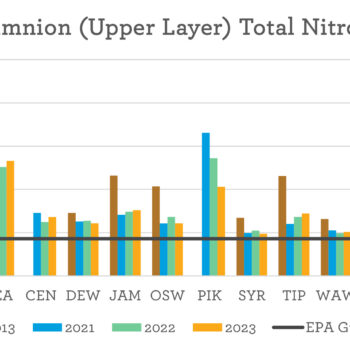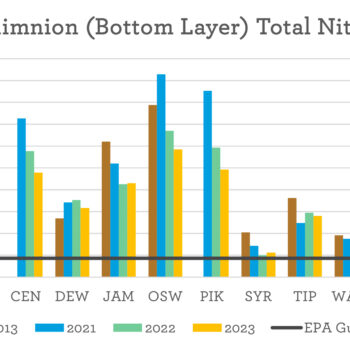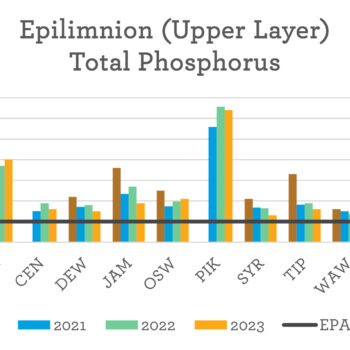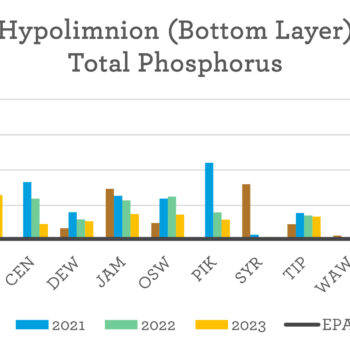Beneath the Surface
Beneath the Surface
You probably love your lake and want to preserve it for future generations – so does our team!
Beneath the Surface will equip you with information that will give your family, organization or agency the ability to care for the lakes. A special thank you to The Papers and the Renda family for making this publication possible.
The Lilly Center launched back in 2007. We believe that a countywide lakes culture needs countywide research, education, and collaboration, so our team crafts original content for those in kindergarten through retirement. Due to the Lilly Center’s work, the lakes in Kosciusko County are some of the best studied in Indiana.
We have a library of valuable data that shows patterns and trends in the health of our lakes, which in turn reveals specific management steps. That’s part of the design of this report. After looking at the data, we encourage you to follow the action steps on page 49 and share it with others. A digital copy can be downloaded below.
We invite you to dive Beneath the Surface with us! Keep scrolling to see the combined data and analysis from this year’s report.


Water Clarity
Have you noticed that you assess water clarity when you look off of a pier into the lake or down at your toes while swimming? You take note of whether or not you can see the bottom, or if sinking things disappear into murky depths. The Lilly Center quantifies water clarity using a black-and-white circle called a Secchi disk. Water clarity is reduced by the “stuff” suspended in the water – usually soil particles and algae. A deep Secchi disk reading, represented by a longer bar on the graph below, means clearer water. Clearer water is a sign of less algae and sediment in your lake!
This Secchi disk graph shows the maximum, average, and minimum depths we could see into each lake across all 11 of our weekly measurements during the summer of 2023. The average of all summer 2023 clarity readings was 6.7 ft, compared to 6.8 ft in 2021 and 6.4 ft in 2020. But not every week or lake was the same as last year! Take a look at the individual lake pages, starting on page 20, for more in-depth water clarity comparisons across the past three years.


Dissolved Oxygen
We are not the only ones interested in water quality; fish rely on healthy lakes, too. One threat to Kosciusko County fish is a lack of dissolved oxygen in the summer.
As microbes, fish and other organisms live and “breathe” in the cool, deep water (hypolimnion), the dissolved oxygen content can diminish to zero, forcing fish into the much-warmer upper layer (epilimnion). The stark contrast in water temperature from top to bottom creates these epilimnion and hypolimnion layers, a boundary that dissolved oxygen and some other molecules cannot pass through until autumn cools the top water again. That is when water moves freely from top to bottom, replenishing dissolved oxygen throughout the lake.
By reducing the amount of material decomposing at the bottom of a lake, we can hopefully slow the use of dissolved oxygen and reclaim deeper, cooler water habitat for fish during the summer!
The lakes in this graph are organized from shallowest to deepest at their deepest point (gray bars show total depth). The longer the colored bars in this graph, the deeper the oxygen, the more habitat there is for fish! At bare minimum, fish require at least 2.0 mg/L of oxygen in the water to survive, so the colored bars represent where dissolved oxygen was measured greater than or equal to 2.0 mg/L. Many species of fish, however, need three or more times that amount to thrive and produce healthy offspring, and many rely on colder temperatures than can be found in the oxygenated upper layer of lake water in the summer.

Is dissolved oxygen different from "regular" oxygen?
Nope! Dissolved oxygen simply refers to the molecule’s state when it’s mixed into lake water. Fish are able to draw dissolved oxygen through their gills; the roots of aquatic plants can absorb it, too.
Nutrients
The four graphs below show two nutrients (phosphorus and nitrogen) in two layers of lake water: the epilimnion and the hypolimnion, defined on the previous page. In order to get a full picture of lake nutrient levels, we sample both layers.
Phosphorus and nitrogen are nutrients that directly influence lake health. They are chemical elements necessary to support aquatic life, starting with the rooted plants (weeds) and phytoplankton (algae) that make up the base of the food chain.
Nutrients have a positive, healthy connotation for people. Just as eating too much or the wrong foods can be bad for human health, too much phosphorus and nitrogen can damage our lakes and their aquatic residents.
The gray line on each of the nutrient graphs marks the Environmental Protection Agency’s (EPA) calculation of the nutrient content of high-quality lakes in our area. It is a low bar compared to our results; in this graph, a shorter bar is more beneficial. According to our data from the past three years, all 14 lakes we sample need fewer nutrients to increase water clarity and the depth of fish habitats.
Note that the scales on these graphs are different, highlighting the fact that there are typically more nutrients in the hypolimnion than epilimnion in our lakes. That indicates that nutrients are not only coming from inflowing streams, but the lake bottom itself, too. (This is called “nutrient loading”.)
You can also see that Big Chapman, Syracuse and Wawasee lakes have relatively low total phosphorus concentrations in their hypolimnion layer, indicating less nutrient loading from the sediments in these lakes at their deepest point.
The EPA guideline for total phosphorus is 0.010 mg P/L. The average total phosphorus across all 2023 epilimnion samples was 0.024 mg P/L, while the hypolimnion was 0.154 mg P/L. The EPA total nitrogen guideline is 0.43 mg N/L. The 2023 overall average total nitrogen was 0.77 mg N/L in the epilimnion and 2.034 mg N/L in the hypolimnion.


Blue-green algae & microcystin
Blue-green algae (BGA) are a photosynthesizing, increasingly-prevalent, potentially toxin-producing family of bacteria natural to freshwater. Not every species of BGA creates toxins, and the toxin-producing species do not always produce toxin. Though BGA are abundant in our lakes, data from the past four years shows that microcystin toxin averages at or near levels of concern for pets (0.8 ppb). While our BGA are capable of producing higher levels, typical levels do not approach the IDEM’s guideline for human health concern (8.0 ppb; four times higher than this graph’s scale) for our lakes.
Most of the Lilly Center’s time spent investigating our lakes does not take place on the water at all, but in a lab! A team of trained undergraduate students, lead by Grace College professor Dr. Joseph Frentzel, have spent the summer of 2022 identifying and counting thousands of individual algae cells.
Out of all water samples assessed so far, 88% of cells have been blue-green algae rather than green algae or other cells, and 67% of the BGA genera, or groups, found in our lakes are capable of producing toxin. 3.8% of our summer microcystin samples exceeded IDEM’s pet recreation threshold.
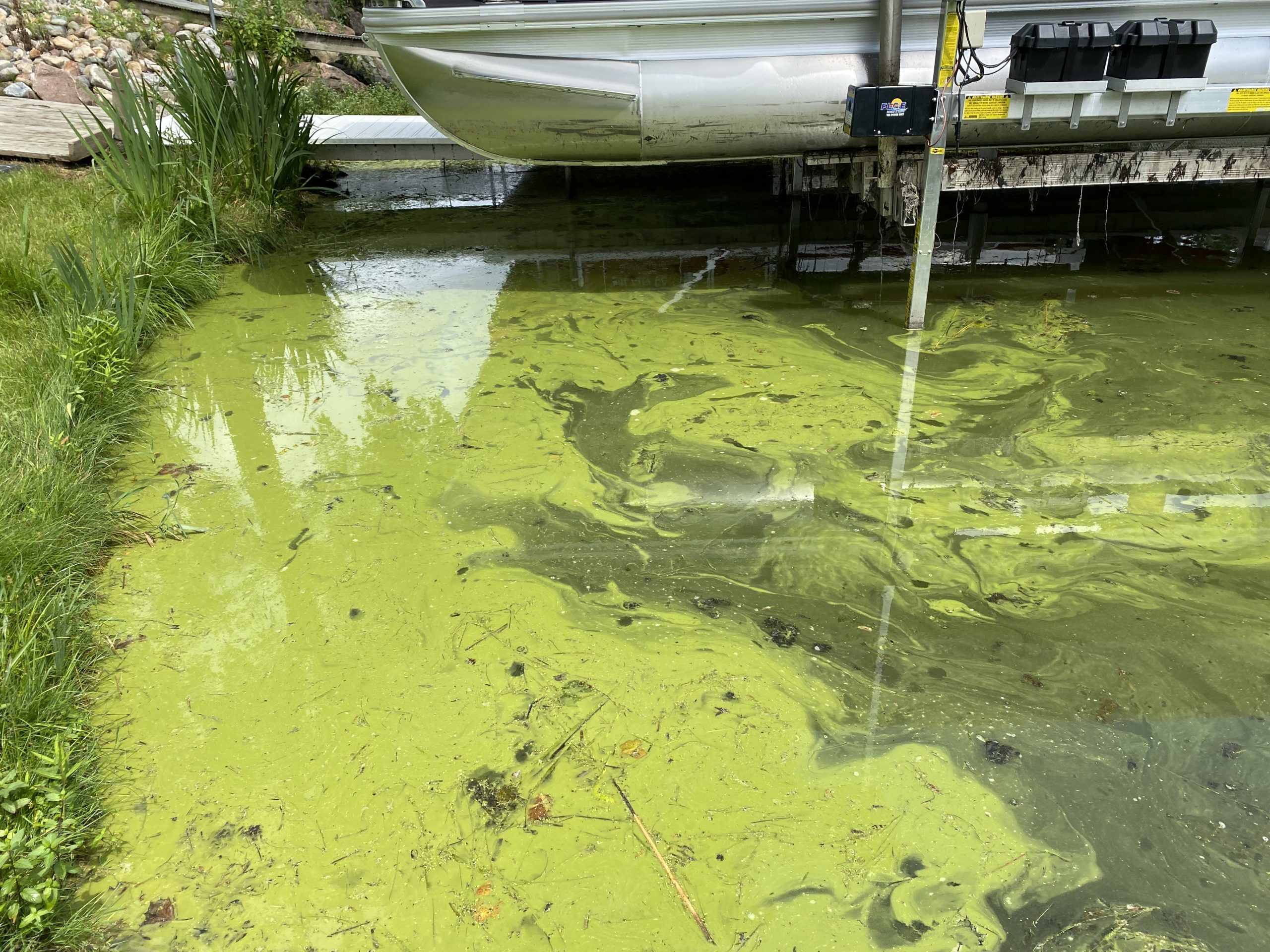
How do nutrients get into the lakes?
Streams, lawns, storm drains, pipes, decomposing materials already in the lake … the list is almost endless! Nutrients are essential for a lake’s health, but too many nutrients can be a bad thing.
Where can I see last year's Beneath the Surface?
Use the buttons below to download previous editions of Beneath the Surface.
What's going on in MY lake, and how can I get involved?
We study 14 lakes, all of which are represented in Beneath the Surface:
- Beaver Dam Lake
- Big Barbee Lake
- Big Chapman Lake
- Center Lake
- Dewart Lake
- James Lake
- Oswego Lake
- Pike Lake
- Syracuse Lake
- Lake Tippecanoe
- Lake Wawasee
- Webster Lake
- Winona Lake
- Yellow Creek Lake
Download a copy to find out the current state of your lake’s health.
Want to get involved at the lake-level? Find out if your lake has a lake association, or if one of the many local governmental/conservation associations is taking volunteers. Here are the ones we regularly partner with.
BARBEE LAKES PROPERTY OWNERS ASSOCIATION
North Webster, IN | barbeelakes.org
BEAVER DAM & LOON LAKE CONSERVATION CLUB
Claypool, IN | Find them on Facebook
CENTER LAKE CONSERVATION ASSOCIATION
Warsaw, IN | Find them on Facebook
CHAPMAN LAKES CONSERVATION ASSOCIATION
Warsaw, IN | chapmanlake.com
DEWART LAKE PROTECTIVE ASSOCIATION
Syracuse, IN | dewartlake.org
LAKE TIPPECANOE PROPERTY OWNERS ASSOCIATION
Leesburg, IN | ltpo.org
PIKE LAKE ASSOCIATION
Warsaw, IN | Find them on Facebook
WAWASEE PROPERTY OWNERS ASSOCIATION
Syracuse, IN | wawaseepoa.org
WEBSTER LAKE CONSERVATION ASSOCIATION
North Webster, IN | lakewebster.net
WINONA LAKE PRESERVATION ASSOCIATION
Winona Lake, IN | winonalakepreservation.com
SYRACUSE LAKE ASSOCIATION
Syracuse, IN | Find them on Facebook
YELLOW CREEK LAKE CONSERVATION CLUB
Claypool, IN | Find them on Facebook
CITY OF WARSAW STORMWATER UTILITY
Warsaw, IN | warsaw.in.gov/301/stormwater-utility
U.S. ENVIRONMENTAL PROTECTION AGENCY
epa.gov
INDIANA DEPARTMENT OF ENVIRONMENTAL MANAGEMENT
Indianapolis, IN | in.gov/idem
INDIANA DEPARTMENT OF NATURAL RESOURCES
Indianapolis, IN | in.gov/dnr
KOSCIUSKO COUNTY CONVENTION, RECREATION AND VISITORS COMMISSION
Warsaw, IN
KOSCIUSKO COUNTY SOIL AND WATER CONSERVATION DISTRICT
Warsaw, IN | kosciuskoswcd.org
THE WATERSHED FOUNDATION
North Webster, IN | watershedfoundation.org
WAWASEE AREA CONSERVANCY FOUNDATION
Syracuse, IN | wacf.com
Beneath the Surface is made possible by The Papers and the Renda family, and the Lilly Center’s blue-green algae research is supported by K21 Health Foundation, among many others generous families and individuals. Thank you!
